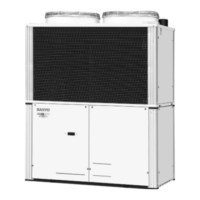Do you have a question about the Sanyo R410A and is the answer not in the manual?
Lists essential tools needed for installation that are not included with the unit.
Details the components and accessories provided with the air conditioning unit.
Specifies the required types of copper tubing and insulation for refrigerant lines.
Lists other materials needed for completing the installation process.
Outlines allowable lengths and differences for refrigerant tubing runs.
Provides guidance on selecting appropriate sizes for refrigerant tubing based on capacity.
Details equivalent straight lengths for various tubing joints to calculate system pressure drop.
Explains how to calculate the extra refrigerant needed based on tubing length and size.
Defines the maximum number of connected units and capacity ratios for the system.
Covers general standards for installing air conditioning units and refrigerant tubing.
Specifies checks for room density limits to ensure refrigerant gas safety.
Provides instructions and precautions for installing distribution joints in the refrigerant piping.
Information on optional kits for creating branches in the refrigerant piping system.
Details on installing the optional solenoid valve kit for refrigerant control.
An example illustrating tubing size selection and refrigerant charge calculation.
Guidelines and avoidances for selecting a suitable site for the outdoor unit.
Specific measures for installing outdoor units in locations prone to heavy snowfall.
Diagrams showing dimensions for wind ducting connections to the unit.
Diagrams illustrating dimensions for snow-proof ducting for the unit.
Instructions on how to safely transport and handle the outdoor unit.
Guidance on securely anchoring and mounting the outdoor unit in its designated location.
Steps to remove protective brackets after the unit is installed.
Instructions on how to route the refrigerant tubing from the unit.
Steps for preparing the copper tubes, including cutting and flaring.
Procedures for connecting the refrigerant tubing to the unit's ports.
Important safety and installation rules for electrical wiring.
Guidelines for selecting wire length and diameter for power supply and control wiring.
Illustrates the electrical connections between indoor, outdoor, and control units.
Detailed steps for connecting refrigerant tubes using the flaring technique.
Instructions for connecting the refrigerant lines between indoor and outdoor units.
Guidance on applying thermal insulation to refrigerant tubing for proper performance.
Instructions on how to tape refrigerant tubes and electrical wiring together.
Steps for sealing wall openings after tubing installation to prevent drafts and rain.
Steps for preparing the system for air purging using a vacuum pump.
Instructions for performing leak tests and evacuating the refrigerant system.
Procedures for charging additional refrigerant and completing the system setup.
Checks to perform before starting the system test run.
Step-by-step guide for conducting the system's operational test run.
Instructions for configuring settings on the outdoor unit's main control PCB.
Guide for automatically setting addresses for indoor and outdoor units.
How to configure the remote controller for system testing.
Warnings and procedures related to refrigerant pump down.
Explains the meaning of various alarm codes and LED indicators.
| Brand | Sanyo |
|---|---|
| Model | R410A |
| Category | Air Conditioner |
| Language | English |












